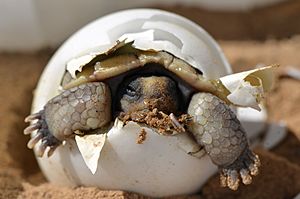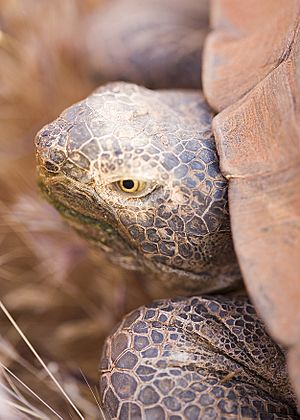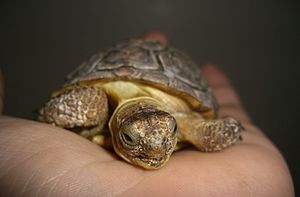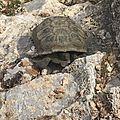Desert tortoise facts for kids
Quick facts for kids Desert tortoise |
|
|---|---|
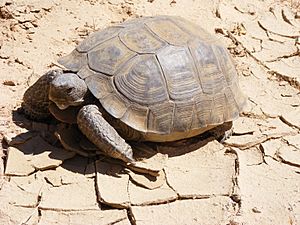 |
|
| Agassiz's desert tortoise, G. agassizii | |
| Conservation status | |
|
Temporarily Endangered (CDFW)
|
|
| Scientific classification | |
| Genus: |
Gopherus
|
| Species: |
agassizii
|
| Synonyms | |
|
|
The desert tortoise (Gopherus agassizii) is a type of tortoise that lives in the Mojave and Sonoran Deserts. These deserts are found in the southwestern United States and northwestern Mexico. You can find G. agassizii in western Arizona, southeastern California, southern Nevada, and southwestern Utah. This tortoise was named after a Swiss-American zoologist, Jean Louis Rodolphe Agassiz.
In 2011, scientists learned that there are actually two different kinds of desert tortoises. This was based on their DNA, where they live, and how they act. The two types are Agassiz's desert tortoise (Gopherus agassizii) and Morafka's desert tortoise (Gopherus morafkai). Morafka's desert tortoise lives east of the Colorado River in Arizona, and also in Sonora and Sinaloa, Mexico. The new name G. morafkai honors Professor David Joseph Morafka, who studied and helped protect these tortoises.
Desert tortoises can live a long time, usually between 50 and 80 years. They grow slowly and don't have many babies. They spend most of their lives in burrows, which are like underground tunnels. This helps them stay cool in hot weather and save water. They are most active when it rains. During very hot or cold times, they stay inactive to save water and survive.
Contents
What Does a Desert Tortoise Look Like?
These tortoises can grow to be about 10 to 14 inches (25 to 36 cm) long. Male tortoises are usually a bit bigger than females. Males also have a longer horn-like part under their chin and a curved bottom shell (plastron). Females have flatter bottom shells. Males also have bigger tails.
Their shells are tall and rounded, and they can be greenish-tan to dark brown. Desert tortoises can be 4 to 6 inches (10 to 15 cm) tall. They can weigh from less than a pound to about 11 pounds (0.02 to 5 kg). Their front legs are flat and have sharp, claw-like scales, which are perfect for digging. Their back legs are thinner and quite long.
Where Do Desert Tortoises Live?
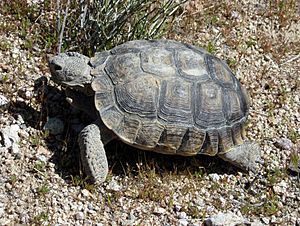
Desert tortoises can live in places where the ground gets hotter than 140°F (60°C). They can do this because they dig burrows to escape the heat. They spend at least 95% of their lives inside these burrows. Burrows also protect them from freezing winter weather, especially when they are inactive from November to March. The underground homes they create can also help other animals like reptiles, mammals, birds, and insects.
Scientists have found that Agassiz's desert tortoise lives in different kinds of places. These include sandy flat areas and rocky hills. In the Mojave Desert, they especially like areas with loose soil, like alluvial fans and canyons. These spots have good soil for digging their dens. They live from sea level up to about 3,500 feet (1,067 m) high. Tortoises tend to stay in the same areas. They know where to find food, water, and minerals.
Desert tortoises live at different heights, from below sea level in Death Valley to 5,300 feet (1,615 m) in Arizona. They are most common between 1,000 and 3,500 feet (305 to 1,067 m). The number of tortoises in an area can vary a lot. Their home range is usually about 10 to 100 acres (4 to 40 hectares). Males generally have larger home ranges than females. Their home range grows bigger when there is more food and rain.
Soil type is very important for desert tortoises. This is because they rely on burrows for shelter and to control their body temperature. The soil needs to be easy to dig but also strong enough not to collapse. They prefer sandy loam soils that have some gravel and clay. They usually avoid very sandy soils or those that don't hold water well. They might even eat soil to get enough calcium.
Tortoise Shelters
Desert tortoises spend most of their lives in burrows, rock shelters, or shallow dips in the ground called pallets. These shelters help them control their body temperature and keep from losing too much water. Burrows are tunnels they dig, rock shelters are spaces under rocks, and pallets are just shallow holes. Tortoises use different types of shelters depending on what's available and the weather.
The number of burrows a tortoise uses can change. They might use some burrows again and again, sometimes for several years. Male tortoises often dig deeper burrows than females. The way they use burrows also changes with the seasons and where they live. Tortoise shelters are often found near plants or rocks that offer cover. Female tortoises often lay their eggs in nests dug in the soil near the entrance of burrows or under bushes. These nests are usually 3 to 10 inches (8 to 25 cm) deep.
Shelters are super important for tortoises. They help tortoises stay cool in summer and warm in winter. The air inside burrows is humid, which stops them from drying out. Burrows also protect them from animals that might try to eat them. Having enough good burrow spots helps more tortoises live in an area.
A desert tortoise might use about 5 to 25 different burrows each year. Some burrows are used over and over. Tortoises sometimes share their burrows with other animals. These can include white-tailed antelope squirrels, woodrats, collared peccaries, burrowing owls, Gambel's quail, rattlesnakes, Gila monsters, beetles, spiders, and scorpions. One burrow can even host up to 23 desert tortoises! Sharing is more common between male and female tortoises than between tortoises of the same sex.
Desert Tortoise Life Cycle
How Desert Tortoises Reproduce
Tortoises mate in the spring and autumn. When it's mating season, male desert tortoises grow two white glands near their chin.
A few months after mating, the female lays a group of four to eight hard-shelled eggs. These eggs are about the size and shape of ping-pong balls. She usually lays them in June or July, and they hatch in August or September. Wild female tortoises can lay up to three groups of eggs each year, depending on the weather. The eggs take about 90 to 135 days to hatch. Sometimes, eggs laid late in the year might stay in the nest over winter and hatch the next spring. The temperature of the nest can affect how many eggs hatch and whether the babies are male or female.
Growing Up
Desert tortoises grow slowly. It can take them 16 years or even longer to reach about 8 inches (20 cm) in length. How fast they grow depends on their age, where they live, if they are male or female, and how much rain there is. For example, they might grow about 12 mm per year when they are 4-8 years old, but only about 6 mm per year when they are 16-20 years old. Males and females grow at similar rates, but males usually end up larger.
Desert tortoises are typically ready to have babies when they are 15 to 20 years old. By then, they are usually longer than 7 inches (18 cm). However, some females have been seen having babies when they are as young as 10 years old.
Daily Activities
How active desert tortoises are depends on where they live. In the Mojave Desert, they are most active in late spring. In the Sonoran Desert, they are most active in late summer to fall. Some groups of tortoises might have two active periods in one year. Desert tortoises go into a special kind of winter sleep called brumation from about November to February or April. Females start brumating later and wake up earlier than males. Young tortoises also wake up earlier than adults.
Temperature greatly affects how active a desert tortoise is. While they can survive in temperatures from below freezing to over 104°F (40°C), they are most active when temperatures are between 79°F and 93°F (26°C and 34°C). This means they are often active in the late morning during spring and fall. In summer, they might be active early in the morning and late in the evening. Sometimes, they even become active on warm winter afternoons. Their activity generally increases after it rains.
Even though desert tortoises spend most of their time in shelters, they commonly move up to 660 feet (200 m) per day. These shorter movements are usually for finding food, traveling between burrows, or looking for a mate. Longer movements might mean they are exploring new areas or using different parts of their home range.
How Long Do They Live?
Desert tortoises can live for more than 50 years, with some living 50 to 80 years. Things that can cause them to die include predators, diseases, human activities, and environmental factors like drought, floods, and fires.
The number of adult tortoises that die each year is usually small. However, many young tortoises don't survive. Only about 2-5% of baby tortoises are thought to make it to adulthood. For Mojave Desert tortoises, about 47-51% survive their first year. From ages 1 to 4, about 71-89% survive.
What Do Desert Tortoises Eat?
The desert tortoise is a herbivore, meaning it only eats plants. Most of its diet is made up of grasses. But it also eats other plants, wildflowers, and new growth from cacti, including their fruit and flowers. They sometimes eat rocks and soil. This might help them get important minerals like calcium or help with digestion. Like birds, they might use small stones in their stomach to help break down plant material.
Most of the water a tortoise gets comes from the moisture in the grasses and wildflowers they eat in the spring. They have a large urinary bladder that can hold a lot of water, along with waste products. In very dry times, they might get rid of waste as a white paste instead of watery urine. When it rains a lot, they drink as much as they can from puddles. They can increase their body weight by up to 40% after drinking a lot. Adult tortoises can live a year or more without drinking water. During summer and dry seasons, they get water from cactus fruits and mesquite grass. To save water, they can reabsorb water from their bladders. They also move to humid burrows in the morning to prevent water loss.
Emptying their bladder is one way this tortoise defends itself. This can be very dangerous for the tortoise in dry areas. So, you should never scare, touch, or pick up a wild desert tortoise unless it is in immediate danger. If you must handle one and it empties its bladder, you should offer it water to help it get its fluids back.
Protecting Desert Tortoises
As of 2021, there are about 100,000 desert tortoises living in the Mojave and Sonoran deserts. Animals like Ravens, Gila monsters, kit foxes, badgers, roadrunners, coyotes, and fire ants are natural predators of the desert tortoise. They mostly eat eggs and young tortoises, which have soft shells. Ravens can cause a lot of problems for young tortoises near cities.
The biggest threats to tortoises come from humans. These include cities growing bigger, diseases, losing their homes, and being illegally collected as pets. Also, new types of plants that aren't native to the desert can take over their habitat.
Desert tortoise numbers in some areas have dropped by as much as 90% since the 1980s. The Mojave population is now listed as threatened. It is against the law to touch, harm, bother, or collect wild desert tortoises. However, you can adopt captive tortoises through special programs in Arizona, Utah, California, or Nevada. In Nevada, adopted tortoises even get a tiny computer chip on their backs for identification.
Sometimes, big projects like military training areas or new wind and solar farms can affect tortoise habitats. When these projects are built, efforts are made to move tortoises to safer areas. However, these projects can still cause habitat loss for many tortoises.
Conservation Efforts
The Desert Tortoise Preserve Committee works to protect about 5,000 acres of desert tortoise habitat. This land is kept safe from human activities.
Diseases Affecting Tortoises
Reptiles can get sick from many different germs, like viruses, bacteria, and parasites. Desert tortoises, specifically G. agassizii, have been harmed by several diseases. These include upper respiratory tract disease, a shell disease called cutaneous dyskeratosis, and herpes virus. They can also get bladder stones and parasites.
Upper Respiratory Tract Disease
Upper respiratory tract disease (URTD) is a long-lasting infection that has caused many desert tortoises to die. It was first found in tortoises kept as pets in the 1970s and later in wild tortoises. URTD is caused by tiny bacteria called Mycoplasma agassizii and Mycoplasma testudineum.
These bacteria can be very harmful to some tortoise groups, while in others, they might just cause a mild or hidden infection. We don't fully understand why this happens. When a tortoise has URTD, it might have a runny nose or eyes, swollen eyelids, lose weight, or act tired. The disease likely spreads when sick tortoises come into contact with healthy ones. Studies in the Mojave Desert showed that the number of tortoises exposed to M. agassizii increased by 37% between 1992 and 1995.
Shell Disease (Cutaneous Dyskeratosis)
Cutaneous dyskeratosis (CD) is a shell disease that scientists don't fully understand yet. It causes spots and damage on the tortoise's shell. The affected areas look discolored, dry, rough, and flaky. The shell might peel, pit, or chip. This disease usually starts on the bottom shell (plastron) but can also appear on the top shell (carapace) and front legs. In serious cases, the exposed areas can get infected with bacteria or fungi, and the tissue and bone might die. CD was first seen in 1979. We don't know how it spreads, but some ideas include problems with the tortoise's immune system, exposure to harmful chemicals, or not getting enough nutrients from their food.
How Diseases Impact Tortoises
Studies have shown how diseases spread among desert tortoises. For example, in one area, URTD spread from a central spot to nearby areas over two years. This suggests that healthy tortoises can quickly get sick if they are near infected ones. Wild tortoises living close to human areas might be more likely to get sick because of human activities.
Another study showed that tortoises kept as pets can spread diseases to wild tortoises. Researchers tested pet tortoises and found that many had been exposed to mycoplasma (82.7%) and herpesvirus (26.6%). It's estimated that about 200,000 captive desert tortoises live in California. If these pets escape or are released into the wild, they could easily spread diseases to healthy wild tortoise populations. This is a serious threat to their survival.
Managing Diseases and Education
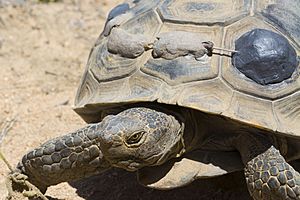
To help wild tortoises, we need to manage diseases effectively. This means doing more research and educating people. Even with a lot of research, we still don't fully understand how diseases affect tortoise populations. For example, we don't know if tortoise numbers would still drop if there were no diseases. Are tortoises more likely to get sick during droughts? How does eating non-native plants affect their ability to fight off germs? Why are some tortoises naturally resistant to diseases?
It's important to find and protect tortoises that are resistant to diseases. Also, learning more about how tortoises interact with each other can help us understand how diseases spread. Moving tortoises from one place to another should be done very carefully, as it can accidentally spread diseases.
Education is also key to stopping the spread of diseases from pet tortoises to wild ones. Vets, government groups, schools, and museums can teach people not to breed their pet tortoises. They can also explain why different types of turtles and tortoises shouldn't be housed together. It's also important to make sure pet tortoises can't escape into the wild and that they are never released.
Diseases have greatly harmed desert tortoises. Both URTD and shell disease have caused many tortoises to die. These diseases are very likely linked to human actions, especially people releasing pet tortoises into the wild. Combining scientific research with public education is crucial to stop diseases from spreading and help the desert tortoise recover.
State Reptile
The desert tortoise is the official state reptile of California and Nevada.
Images for kids
- Behler JL, King FW (1979). The Audubon Society Field Guide to North American Reptiles and Amphibians. New York: Alfred A. Knopf. 743 pp. ISBN: 0-394-50824-6. (Gopherus agassizii, pp. 471–472 + Plate 328).
- Boulenger GA (1889). Catalogue of the Chelonians, Rhynchocephalians, and Crocodiles in the British Museum (Natural History). New Edition. London: Trustees of the British Museum (Natural History). (Taylor and Francis, printers). x + 311p. + Plates I-III. (Testudo agasizii, p. 156).
- Cooper JG (1861). "New California Animals". Proc. California Acad. Sci. 2: 118-123. (Xerobates agassizii, new species, pp. 120–121).
- Goin CJ, Goin OB, Zug GR (1978). Introduction to Herpetology, Third Edition. San Francisco: W.H. Freeman. xi + 378 pp. ISBN: 0-7167-0020-4. (Gopherus agassizi, p. 155).
- Smith HM, Brodie ED Jr (1982). Reptiles of North America: A Guide to Field Identification. New York: Golden Press. 240 pp. ISBN: 0-307-13666-3 (paperback), ISBN: 0-307-47009-1 (hardcover). (Gopherus agassizi, pp. 62–63).
- Stebbins RC (2003). A Field Guide to Western Reptiles and Amphibians, Third Edition. The Peterson Field Guide Series ®. Boston and New York: Houghton Mifflin. xiii + 533 pp. ISBN: 978-0-395-98272-3. (Gopherus agassizii, pp. 255–257 + Plate 22 + Map 63).
- Stejneger L, Barbour T (1917). A Check List of North American Amphibians and Reptiles. Cambridge, Massachusetts: Harvard University Press. 125 pp. (Gopherus agassizii, p. 121).
See also
 In Spanish: Tortuga del Desierto de Mojave para niños
In Spanish: Tortuga del Desierto de Mojave para niños


